[English] 日本語
 Yorodumi
Yorodumi- PDB-1kzy: Crystal Structure of the 53bp1 BRCT Region Complexed to Tumor Sup... -
+ Open data
Open data
- Basic information
Basic information
| Entry | Database: PDB / ID: 1kzy | ||||||
|---|---|---|---|---|---|---|---|
| Title | Crystal Structure of the 53bp1 BRCT Region Complexed to Tumor Suppressor P53 | ||||||
 Components Components |
| ||||||
 Keywords Keywords | DNA BINDING PROTEIN / PROTEIN BINDING / TANDEM-BRCT AND LINKER COMPLEXED WITH NON-BRCT PROTEIN / THREE-HELIX BUNDLE / PARALLEL BETA SHEET | ||||||
| Function / homology |  Function and homology information Function and homology informationubiquitin-modified histone reader activity / positive regulation of isotype switching / histone H4K20me2 reader activity / cellular response to X-ray / double-strand break repair via classical nonhomologous end joining / protein localization to site of double-strand break / negative regulation of helicase activity / Loss of function of TP53 in cancer due to loss of tetramerization ability / Regulation of TP53 Expression / signal transduction by p53 class mediator ...ubiquitin-modified histone reader activity / positive regulation of isotype switching / histone H4K20me2 reader activity / cellular response to X-ray / double-strand break repair via classical nonhomologous end joining / protein localization to site of double-strand break / negative regulation of helicase activity / Loss of function of TP53 in cancer due to loss of tetramerization ability / Regulation of TP53 Expression / signal transduction by p53 class mediator / negative regulation of G1 to G0 transition / negative regulation of glucose catabolic process to lactate via pyruvate / Transcriptional activation of cell cycle inhibitor p21 / regulation of intrinsic apoptotic signaling pathway by p53 class mediator / negative regulation of pentose-phosphate shunt / ATP-dependent DNA/DNA annealing activity / Activation of NOXA and translocation to mitochondria / regulation of cell cycle G2/M phase transition / oligodendrocyte apoptotic process / negative regulation of miRNA processing / intrinsic apoptotic signaling pathway in response to hypoxia / regulation of fibroblast apoptotic process / positive regulation of thymocyte apoptotic process / oxidative stress-induced premature senescence / regulation of tissue remodeling / positive regulation of mitochondrial membrane permeability / mRNA transcription / bone marrow development / positive regulation of programmed necrotic cell death / DNA repair complex / circadian behavior / T cell proliferation involved in immune response / regulation of mitochondrial membrane permeability involved in apoptotic process / germ cell nucleus / RUNX3 regulates CDKN1A transcription / glucose catabolic process to lactate via pyruvate / TP53 Regulates Transcription of Death Receptors and Ligands / Activation of PUMA and translocation to mitochondria / TP53 regulates transcription of additional cell cycle genes whose exact role in the p53 pathway remain uncertain / regulation of DNA damage response, signal transduction by p53 class mediator / histone deacetylase regulator activity / negative regulation of glial cell proliferation / Regulation of TP53 Activity through Association with Co-factors / negative regulation of neuroblast proliferation / mitochondrial DNA repair / T cell lineage commitment / Formation of Senescence-Associated Heterochromatin Foci (SAHF) / ER overload response / thymocyte apoptotic process / B cell lineage commitment / TP53 Regulates Transcription of Caspase Activators and Caspases / telomeric DNA binding / cardiac septum morphogenesis / negative regulation of mitophagy / negative regulation of DNA replication / entrainment of circadian clock by photoperiod / negative regulation of telomere maintenance via telomerase / Zygotic genome activation (ZGA) / : / positive regulation of release of cytochrome c from mitochondria / PI5P Regulates TP53 Acetylation / Association of TriC/CCT with target proteins during biosynthesis / necroptotic process / TP53 Regulates Transcription of Genes Involved in Cytochrome C Release / histone reader activity / TFIID-class transcription factor complex binding / SUMOylation of transcription factors / TP53 regulates transcription of several additional cell death genes whose specific roles in p53-dependent apoptosis remain uncertain / intrinsic apoptotic signaling pathway by p53 class mediator / rRNA transcription / negative regulation of reactive oxygen species metabolic process / Transcriptional Regulation by VENTX / positive regulation of intrinsic apoptotic signaling pathway by p53 class mediator / cellular response to UV-C / replicative senescence / general transcription initiation factor binding / cellular response to actinomycin D / intrinsic apoptotic signaling pathway in response to endoplasmic reticulum stress / positive regulation of RNA polymerase II transcription preinitiation complex assembly / neuroblast proliferation / intrinsic apoptotic signaling pathway in response to DNA damage by p53 class mediator / positive regulation of execution phase of apoptosis / viral process / Pyroptosis / hematopoietic stem cell differentiation / response to X-ray / embryonic organ development / chromosome organization / type II interferon-mediated signaling pathway / somitogenesis / negative regulation of double-strand break repair via homologous recombination / TP53 Regulates Transcription of Genes Involved in G1 Cell Cycle Arrest / hematopoietic progenitor cell differentiation / glial cell proliferation / negative regulation of fibroblast proliferation / positive regulation of cardiac muscle cell apoptotic process / core promoter sequence-specific DNA binding / negative regulation of stem cell proliferation / cellular response to glucose starvation / mitophagy Similarity search - Function | ||||||
| Biological species |  Homo sapiens (human) Homo sapiens (human) | ||||||
| Method |  X-RAY DIFFRACTION / X-RAY DIFFRACTION /  SYNCHROTRON / SYNCHROTRON /  MAD / Resolution: 2.5 Å MAD / Resolution: 2.5 Å | ||||||
 Authors Authors | Joo, W.S. / Jeffrey, P.D. / Cantor, S.B. / Finnin, M.S. / Livingston, D.M. / Pavletich, N.P. | ||||||
 Citation Citation |  Journal: Genes Dev. / Year: 2002 Journal: Genes Dev. / Year: 2002Title: Structure of the 53BP1 BRCT region bound to p53 and its comparison to the Brca1 BRCT structure. Authors: Joo, W.S. / Jeffrey, P.D. / Cantor, S.B. / Finnin, M.S. / Livingston, D.M. / Pavletich, N.P. | ||||||
| History |
| ||||||
| Remark 300 | BIOMOLECULE: 1 THIS ENTRY CONTAINS THE CRYSTALLOGRAPHIC ASYMMETRIC UNIT WHICH CONSISTS OF 4 ... BIOMOLECULE: 1 THIS ENTRY CONTAINS THE CRYSTALLOGRAPHIC ASYMMETRIC UNIT WHICH CONSISTS OF 4 CHAIN(S). SEE REMARK 350 FOR INFORMATION ON GENERATING THE BIOLOGICAL MOLECULE(S). The biological unit is tentatively defined as a heterodimer. However, the functional biological unit remains to be determined. |
- Structure visualization
Structure visualization
| Structure viewer | Molecule:  Molmil Molmil Jmol/JSmol Jmol/JSmol |
|---|
- Downloads & links
Downloads & links
- Download
Download
| PDBx/mmCIF format |  1kzy.cif.gz 1kzy.cif.gz | 182.2 KB | Display |  PDBx/mmCIF format PDBx/mmCIF format |
|---|---|---|---|---|
| PDB format |  pdb1kzy.ent.gz pdb1kzy.ent.gz | 145.1 KB | Display |  PDB format PDB format |
| PDBx/mmJSON format |  1kzy.json.gz 1kzy.json.gz | Tree view |  PDBx/mmJSON format PDBx/mmJSON format | |
| Others |  Other downloads Other downloads |
-Validation report
| Summary document |  1kzy_validation.pdf.gz 1kzy_validation.pdf.gz | 392.5 KB | Display |  wwPDB validaton report wwPDB validaton report |
|---|---|---|---|---|
| Full document |  1kzy_full_validation.pdf.gz 1kzy_full_validation.pdf.gz | 419.6 KB | Display | |
| Data in XML |  1kzy_validation.xml.gz 1kzy_validation.xml.gz | 21.1 KB | Display | |
| Data in CIF |  1kzy_validation.cif.gz 1kzy_validation.cif.gz | 32.4 KB | Display | |
| Arichive directory |  https://data.pdbj.org/pub/pdb/validation_reports/kz/1kzy https://data.pdbj.org/pub/pdb/validation_reports/kz/1kzy ftp://data.pdbj.org/pub/pdb/validation_reports/kz/1kzy ftp://data.pdbj.org/pub/pdb/validation_reports/kz/1kzy | HTTPS FTP |
-Related structure data
- Links
Links
- Assembly
Assembly
| Deposited unit | 
| ||||||||
|---|---|---|---|---|---|---|---|---|---|
| 1 |
| ||||||||
| Unit cell |
|
- Components
Components
| #1: Protein | Mass: 21945.898 Da / Num. of mol.: 2 / Fragment: DNA-BINDING CORE DOMAIN Source method: isolated from a genetically manipulated source Source: (gene. exp.)  Homo sapiens (human) / Gene: TP53 / Plasmid: pET3d / Species (production host): Escherichia coli / Production host: Homo sapiens (human) / Gene: TP53 / Plasmid: pET3d / Species (production host): Escherichia coli / Production host:  #2: Protein | Mass: 29268.113 Da / Num. of mol.: 2 / Fragment: TANDEM-BRCT DOMAIN Source method: isolated from a genetically manipulated source Source: (gene. exp.)  Homo sapiens (human) / Gene: 53BP1 / Plasmid: pGEX-4T1 / Species (production host): Escherichia coli / Production host: Homo sapiens (human) / Gene: 53BP1 / Plasmid: pGEX-4T1 / Species (production host): Escherichia coli / Production host:  #3: Chemical | #4: Water | ChemComp-HOH / | Has protein modification | Y | |
|---|
-Experimental details
-Experiment
| Experiment | Method:  X-RAY DIFFRACTION / Number of used crystals: 1 X-RAY DIFFRACTION / Number of used crystals: 1 |
|---|
- Sample preparation
Sample preparation
| Crystal | Density Matthews: 2.26 Å3/Da / Density % sol: 45.7 % | ||||||||||||||||||||||||||||||||||||||||||||||||||||||||
|---|---|---|---|---|---|---|---|---|---|---|---|---|---|---|---|---|---|---|---|---|---|---|---|---|---|---|---|---|---|---|---|---|---|---|---|---|---|---|---|---|---|---|---|---|---|---|---|---|---|---|---|---|---|---|---|---|---|
| Crystal grow | Temperature: 277 K / Method: vapor diffusion, hanging drop / pH: 6 Details: PEG4000, sodium citrate, ammonium acetate, pH 6.0, VAPOR DIFFUSION, HANGING DROP, temperature 277K | ||||||||||||||||||||||||||||||||||||||||||||||||||||||||
| Crystal grow | *PLUS Temperature: 4 ℃ / pH: 6.8 | ||||||||||||||||||||||||||||||||||||||||||||||||||||||||
| Components of the solutions | *PLUS
|
-Data collection
| Diffraction | Mean temperature: 103 K | ||||||||||||
|---|---|---|---|---|---|---|---|---|---|---|---|---|---|
| Diffraction source | Source:  SYNCHROTRON / Site: SYNCHROTRON / Site:  NSLS NSLS  / Beamline: X4A / Wavelength: 1.2832,1.2817,1.2622 / Beamline: X4A / Wavelength: 1.2832,1.2817,1.2622 | ||||||||||||
| Detector | Type: ADSC QUANTUM 4 / Detector: CCD / Date: Jun 10, 1999 | ||||||||||||
| Radiation | Monochromator: Double Crystal Monochromator / Protocol: MAD / Monochromatic (M) / Laue (L): M / Scattering type: x-ray | ||||||||||||
| Radiation wavelength |
| ||||||||||||
| Reflection | Resolution: 2.5→15 Å / Num. all: 33403 / Num. obs: 30624 / % possible obs: 91.7 % / Observed criterion σ(F): 0 / Observed criterion σ(I): 0 / Redundancy: 16.4 % | ||||||||||||
| Reflection shell | Resolution: 2.5→2.59 Å |
- Processing
Processing
| Software |
| ||||||||||||||||||||
|---|---|---|---|---|---|---|---|---|---|---|---|---|---|---|---|---|---|---|---|---|---|
| Refinement | Method to determine structure:  MAD / Resolution: 2.5→15 Å / Cross valid method: THROUGHOUT / σ(F): 0 MAD / Resolution: 2.5→15 Å / Cross valid method: THROUGHOUT / σ(F): 0
| ||||||||||||||||||||
| Refinement step | Cycle: LAST / Resolution: 2.5→15 Å
| ||||||||||||||||||||
| Refinement | *PLUS Num. reflection obs: 28192 / σ(F): 0 / % reflection Rfree: 5 % / Rfactor obs: 0.216 | ||||||||||||||||||||
| Solvent computation | *PLUS | ||||||||||||||||||||
| Displacement parameters | *PLUS | ||||||||||||||||||||
| Refine LS restraints | *PLUS
| ||||||||||||||||||||
| LS refinement shell | *PLUS Highest resolution: 2.5 Å / Lowest resolution: 2.6 Å / Rfactor Rfree: 0.395 / Rfactor obs: 0.321 |
 Movie
Movie Controller
Controller


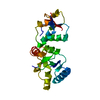
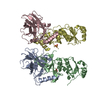
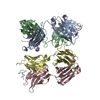
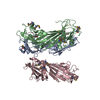
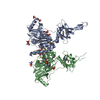
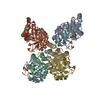

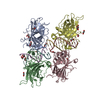

 PDBj
PDBj



















